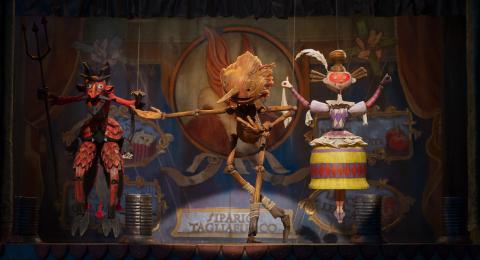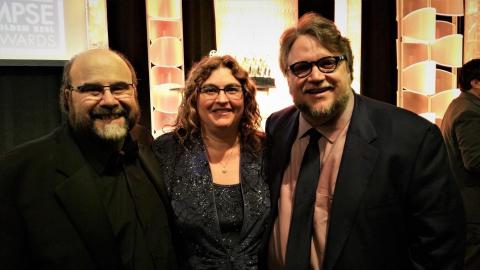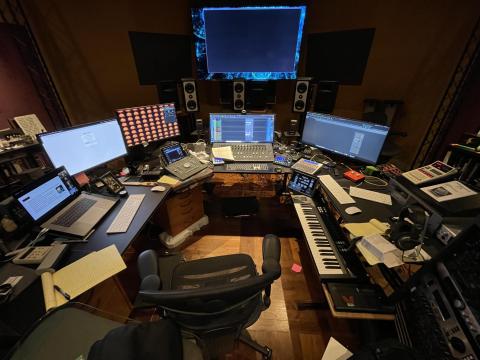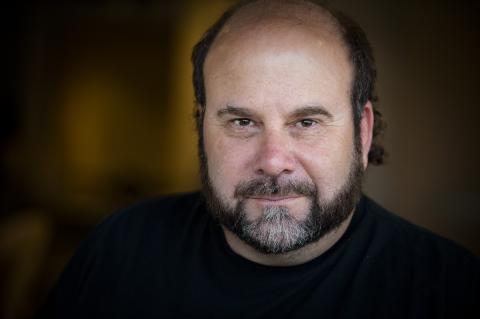How Pinocchio's Sound Supervisor Brought del Toro's Puppet to Life

An image still from Guillermo del Toro's stop-motion adaptation of Pinocchio.
Image courtesy of Netflix

From left: Scott Martin Gershin, Cindy (Manekofsky) Gershin ‘85, Guillermo del Toro
Image courtesy of Scott Martin Gershin

A self-described technology lover, Gershin's sound design studio is his personal sonic canvas.
Image courtesy of Scott Martin Gershin
After 14 months of developing thousands of sounds for Guillermo del Toro’s award-winning new stop-motion version of Pinocchio, the film's sound designer Scott Martin Gershin ’84 had just a couple left to fine-tune. This is how he and his team wound up in a studio whapping pillows against a surface, pausing after each hit to discuss the quality of the thumps and thwacks. “There was a pillow fight between Candlewick and Pinocchio, and it took us a while to find the right pillow,” Gershin said. Picture him on the sound stage, going through a stack of pillows saying, “no, it's too hard. No, it's too soft,” on his journey to getting the right amount of pillow-ness. “It just needed to sound familiar,” he said. And after three decades of doing sound work for dozens of films and video games, Gershin has learned that conjuring the familiar is anything but simple.
“My job is to take sounds and invoke emotions from the audience.... Same as a composer.”
—
Take the character of Pinocchio himself. As a wooden puppet, it wasn’t just a matter of finding any old planks of wood. “I needed Pinocchio to sound like wood, but not be annoying, like somebody's banging a bunch of wood together,” Gershin said. “So, one of the things I did, maybe because of my musical background is—I didn't want to go to Home Depot and just get wood—I had this idea of using guitar wood. I contacted Paul at Paul Reed Smith [PRS], and I saw that a lot of times when they made guitars, there were scraps. So PRS sent me 50 pounds of wood.”
Gershin experimented with many sounds for just Pinocchio himself, eventually whittling it down to eight, with sources originating from wood, metal, and rubber, each squeak and crack supporting Pinocchio’s journey from puppet to human.
Hear some of Gershin's sound designs in this Pinocchio teaser:
Helping a Sound Find Its Voice
In the same way that films need original scores—as opposed to using, say, John Williams’s Star Wars theme for every sci-fi movie—a good sound designer needs a finely tuned ear in order to best attend to the story at hand. “My job is to take sounds and invoke emotions from the audience. I have to figure out how to push an audience's buttons. Same as a composer,” Gershin said. “How do I make tension? How do I make release? How do I support reality or not support reality or create a new reality?”

Scott Martin Gershin
The challenge is, how do you make a new reality sound familiar to your audience? For Gershin, it’s not a matter of just recording a lion when asked for a roar. It may start in reality, but it needs someone to design sounds. “I'll record animals…but none of the animals have any personality. So I'll use and I'll manipulate animal sounds, and then use my voice and combine it,” Gershin said. Using his own voice has become a tried-and-true method for bringing that sense of personality to a soundtrack, and he can be heard as the voice of the dragon in Shrek, the flubber in, well, Flubber, Leatherface from The Texas Chainsaw Massacre, kaiju (monster) sound effects in Pacific Rim, and in Pinocchio, as the dogfish.
“The whole point of it is you could make real, but real can be boring,” he said, explaining that a central question in his work, whether it’s film, TV, video games, or VR, is, “How do you cross the line between fantasy sounds and real sounds in any project?” For Pinocchio, finding an answer to that question involved having to face the unique challenge of working with stop-motion, a style whose textures and feel are “real” in a literal sense, but whose sounds all needed to be supplied by Gershin. Essentially, Gershin had to figure out how to make a pile of wood sound human, transforming "organic sounds into emotions and personalities in concert with the dialogue and the score."
Learning to Listen to Life
Gershin credits his training as a musician as key to developing his skills. At Berklee, his audio engineering studies and work as an assistant in the synth lab helped give him a professional edge. “What I loved about Berklee is that…it allowed you to grow as you wanted to grow. It didn't put limits on you, it didn't put constraints on you. It allowed you to bloom and blossom and experiment as much as you wanted to put into it.”
Being a musician helped tune his ear to “listen to life,” as he puts it. “To me, all of sound is music. When you look at dialogue, or even the sounds of footsteps, there are rhythms. [W]hen I put together a soundtrack, I always think of it musically.”




